Toshiba T235D: AMD's 2010 Ultrathin "Nile" Platform
by Jarred Walton on August 23, 2010 11:00 PM ESTGeneral Performance – Targeting CULV
Our performance testing begins as usual with PCMark Vantage and 05, two comprehensive system benchmarks that stress all areas of performance. As such, it's not only the CPU that but also the hard drive, memory, and graphics chip that determine the result. To go along with PCMark, we have several other general performance tests that focus more on CPU performance. We've included results from a variety of ultraportable laptops for reference. We also have the last gasp of NVIDIA's IGP represented by the old Dell Studio 14z, with a 9400M and P8400 CPU. It doesn't reach the same level of efficiency in terms of battery life (thanks to the non-ULV processor), but keep an eye on its results elsewhere and you can mourn its passing. Intel has ditched the FSB architecture (not a problem, since the FSB was old and in need of an update), but in the process that kills NVIDIA's chance for a current generation IGP supporting modern Intel CPUs.
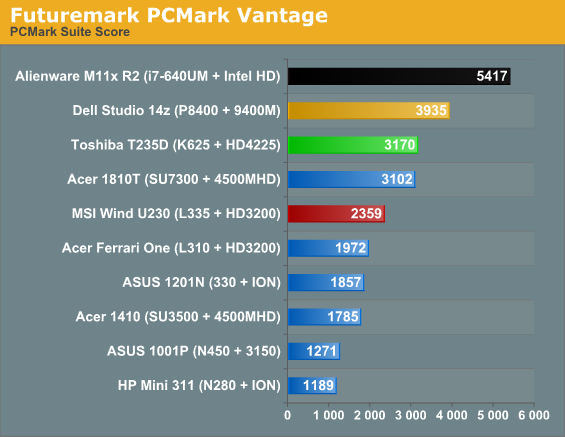

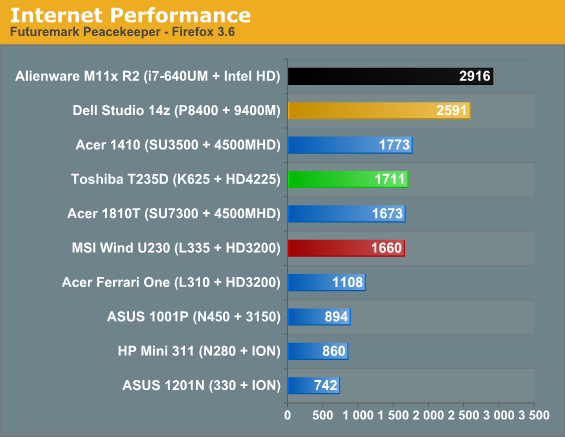
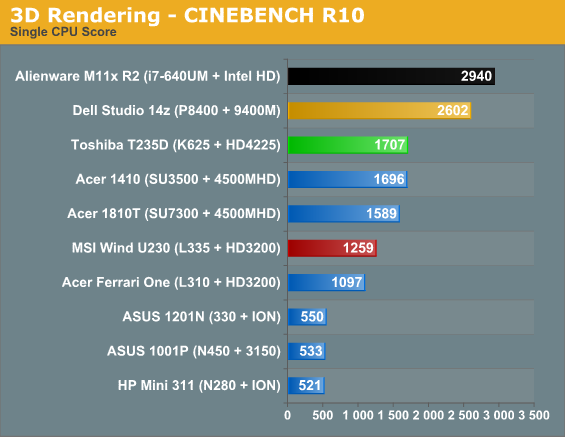
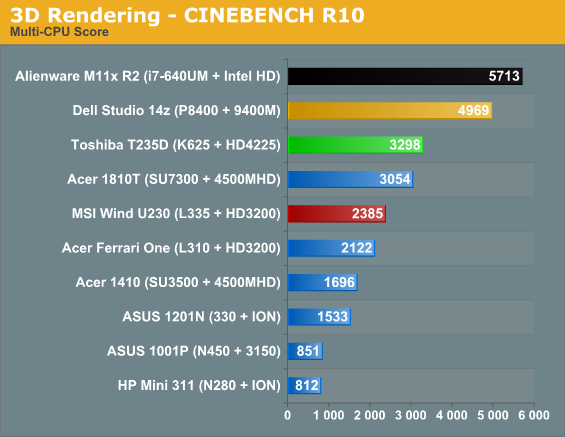
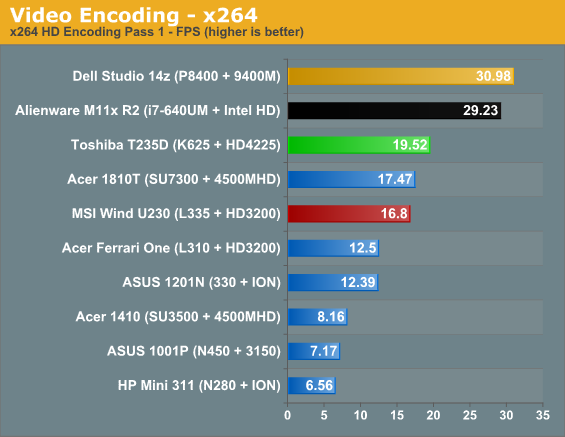
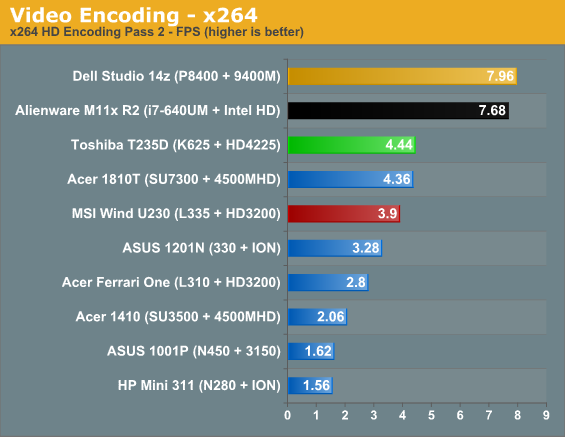
Right off the bat, we can see where the Nile platform (K625) improves over the old Congo offerings. Compared to the slightly faster clocked (1.6GHz) L335 in the Wind U230, the K625 (1.5GHz) in the T235D is at worst equal to Congo (i.e. Peacekeeper), and at best it's around 35% faster (PCMark Vantage and Cinebench). For typical tasks, then, somewhere between 15 to 35 percent faster is a pretty good boost in performance. And Atom is naturally down in the cellar, providing less than half the performance of K625.
Comparing the T235D to the old Intel CULV platform, represented by Acer's 1810T with an SU7300 (1.3GHz), things are closer but the K625 certainly holds its own. Peacekeeper, PCMark Vantage, and x264 (second pass) are basically tied, while Cinebench gives AMD a 7-8% lead and PCMark05 is a 15% lead. Clock for clock Core 2 Duo still looks like it has a small lead, but it's also important to remember that CULV is saddled with a really slow IGP (more on that next). Of course, the competition now isn't between CULV and Nile; instead we have to look to Intel's newer Arrandale ULV parts.
For that comparison, we have the Alienware M11x R2, but with the GeForce GT335M forced off. In this case we're looking at what is practically the top Intel ULV part (the i7-660UM is slightly faster), so this certainly isn't a "fair" comparison. An i7-640UM will run around $300 while the K625 appears to cost closer to $150. Obviously, the M11x R2 is a far more expensive laptop, and the performance bears this out. It's 70% faster in PCMark Vantage (helped no doubt by the 7200RPM HDD), but even when other peripherals aren't involved the i7-640UM is substantially faster than the K625. Cinebench, Peacekeeper, and x264 (second pass) all have the M11x leading by 70 to 75 percent. Intel's Turbo Boost does its job and keeps clocks well above the base 1.2GHz even under heavy loads. So not surprisingly, the expensive i7-640UM blows the K625 away in raw computational performance.
Given the price disparity, it's important to look at other options. We just received an ASUS UL80Jt with an i3-330UM (overclockable, just to make things interesting), and we'll have to wait for that review to get into other Arrandale ULV options. However, we can say that initial testing suggests a stock i3-330UM (1.2GHz but with no Turbo Boost) will be similar to the K625 in lightly threaded loads, while maintaining a 10 to 20 percent lead in heavily threaded benchmarks where Hyper-Threading comes into play. Perhaps even more interesting is that at first glance it appears battery life will be somewhat comparable between the two platforms. When we start to talk about pricing, AMD really has a case to make, but we'll save that for the conclusion. Suffice it to say that in terms of pure application performance, AMD's Nile platform is at least a viable alternative to Intel. It's slightly faster than the old CULV with slightly better pricing, and it's generally less expensive than the Arrandale ULV laptops we've seen so far.










34 Comments
View All Comments
stmok - Tuesday, August 24, 2010 - link
From page 2: "Unfortunately, if you're looking for a more potent IGP from either company, you'll want to wait for Intel's Sandy Bridge and AMD's Bulldozer architectures."=> While the mainstream version of "Sandy Bridge" will have an IGP (coming in early 2011); AMD's Bulldozer won't.
The one's with IGP are AMD's "Ontario" processor (Bobcat cores), and "Llano" processor (K10.5 based, Athlon II-like configuration + Radeon HD 55xx/56xx-based IGP)...These will be the Fusion processors that AMD will bring to the table in late-2010 and early-2011.
Bulldozer-based Fusion processors are expected to come in 2012.
JarredWalton - Tuesday, August 24, 2010 - link
Corrected. I said Bobcat in the other places (AFAIK), but I did mistakenly put Bulldozer in there.Also worth note is that Bobcat isn't just mobile Bulldozer for a change... it's a real reworking for mobility. In fact, not only is it not like Bulldozer, but it's a pretty major change even from K10.5 and K10. More on this in the near future....
Roland00 - Tuesday, August 24, 2010 - link
There are currently some leaked slides saying NDA until tommorrow, furthermore AMD is one of the participants of Stanford Hot Chips Conference. In the program material for the conference there is this detail for Tuesday August 245:00 - 6:30
Session 7: New Processor Architectures (Session Chair: Bevan Baas, UC Davis)
...
# AMD "Bulldozer" Core - a new approach to multithreaded compute performance for maximum efficiency and throughput
Authors: Mike Butler
Affiliations: AMD
# AMD's "Bobcat" x86 Core - Small, Efficient and Strong
Authors: Brad Burgess
Affiliations: AMD
http://www.hotchips.org/printableprogram.php
JarredWalton - Tuesday, August 24, 2010 - link
You can get our HotChips write-up here, now:http://www.anandtech.com/show/3863/amd-discloses-b...
zshift - Tuesday, August 24, 2010 - link
"The Turion II K625 processor comes clocked at a relatively tame 1.5GHz.... The K625 bumps the clock up to 1.7GHz while the K325 drops to 1.3GHz, making the K625 a good middle-of-the-road choice."I believe the second mention of the K625 was supposed to be referring to a different model.
Roland00 - Tuesday, August 24, 2010 - link
K665, 1700 mhzK625 , 1500 mhz
matt b - Tuesday, August 24, 2010 - link
I've been asking for a Nile platform review and Anandtech delievered! I'm glad that your reviewed the k625 too - it seems like the best Nile option, though the K325 1.3 is not much different. It was a good, balanced review. I've seen this one at Office Depot - it's been at $500.00 more than once now. If only Office Depot carried any color other than red.Thanks!
maniac5999 - Tuesday, August 24, 2010 - link
The link from graphics to conclusion didn't appear for me, not sure if it was just a firefox hiccup or if it's missing.Anyway, good article. What is really interesting is the difference in graphics performance between the HD 3200 and HD 4225. Is there any underlying architectural difference, because with the same number of shaders I'd assume that the 3200 at 500mhz would beat the 4225 at 380mhz.
While the platform looks nice, i still think 12" is the magical size for an ultraportable. Oh, and if you sent back your U230 and want to get some numbers for it, please message me and I'll be glad to run numbers for you. (I think I run low 40s on average in SC2 with my 3200 turned up to 3300 speeds)
JarredWalton - Tuesday, August 24, 2010 - link
I missed the page title for the LCD, which messed up the links. That's corrected now.As for the HD 3200 and HD 4225, they're very similar but 4200 series uses UVD2 while 3200 is UVD1. 4000 series is also DX10.1 versus DX10 on the 3200. Per clock performance of the 4200 appears to be higher as well, but I don' t know exactly what changed in that area.
For U230 SC2 numbers, we'd need to send you our test file as well, if we're to keep things apples-to-apples. We did send that one back to MSI, sadly, but I'm not sure if there's much need to retest all the old laptops. We'll be dropping the older stuff from the charts as we move forward and focusing on the newer laptops. Given the pricing and availability, there's not much reason to buy a U230 over the T235D now. I suppose if you want 12", but in that case what you really want is a U230 update with Nile.
maniac5999 - Tuesday, August 24, 2010 - link
well, it'd probably be nice to have a better datapoint for the last generation AMD Ultrathin platform than that turd 'Ferrari One' It would also help us determine if the 4225 is really more powerful than the 3200 or if all those games are just handicapped by the slow Ferarri One processor.It's completely up to you, If you send the file I'll take out my extra 2gb of RAM and run the benchmark.